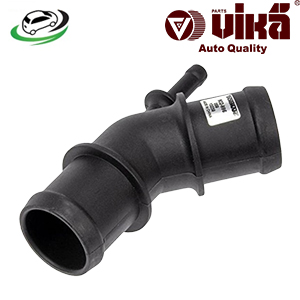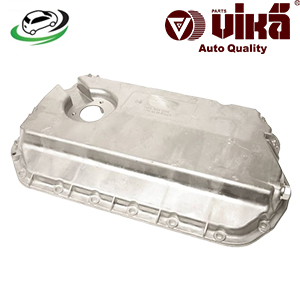-11%
Get Oil Pan VW Passat / Audi S4 A4 A6 2.7L / 2.8L 078103604A
The oil pan, also known as the oil sump, is a crucial component of an internal combustion engine’s lubrication system. It serves as the reservoir that collects and stores engine oil, allowing for the proper lubrication of engine components. Here’s an in-depth look at the oil pan, including its functions, construction, common issues, and maintenance.
Functions of the Oil Pan
- Oil Reservoir
- Collects Engine Oil: The oil pan acts as the storage container for engine oil. It sits at the bottom of the engine block and holds the oil that circulates through the engine to lubricate and cool its components.
- Facilitates Oil Pickup: The oil pan includes an oil pickup tube that draws oil from the pan and directs it to the oil pump. This process ensures that the oil circulates throughout the engine, providing lubrication and cooling.
- Protects the Engine
- Shield from Debris: The oil pan protects the engine’s lower components from debris and contaminants that could cause damage. It acts as a barrier against foreign objects that could potentially enter the oil and affect engine performance.
- Containment of Leaks: By containing the oil within the engine, the oil pan helps prevent leaks that could lead to a loss of lubrication and potential engine damage.
- Cooling
- Oil Temperature Regulation: The oil pan helps in cooling the engine oil by allowing it to collect and dissipate heat. The oil absorbs heat from the engine components and then transfers it to the pan, where it can cool down before being recirculated.
- Heat Dissipation: Some oil pans have cooling fins or external structures designed to enhance heat dissipation, contributing to better engine cooling.
- Facilitates Oil Changes
- Draining Oil: The oil pan is equipped with a drain plug that allows for the removal of old oil during an oil change. This feature is essential for maintaining engine health and ensuring that fresh oil is circulated through the engine.
- Access to Oil Filter: In many designs, the oil filter is positioned near the oil pan, making it easier to access and replace during routine maintenance.
Construction and Design
- Materials
- Steel: Traditional oil pans are often made from stamped steel. Steel is durable and cost-effective, but it can be prone to rust and corrosion over time.
- Aluminum: Many modern oil pans are made from aluminum due to its lightweight properties and resistance to corrosion. Aluminum oil pans are also better at dissipating heat.
- Plastic Composites: Some vehicles use plastic or composite materials for the oil pan, which offer advantages in terms of weight reduction and corrosion resistance, though they may be less durable in some conditions.
- Design Features
- Shape and Size: Oil pans come in various shapes and sizes, depending on the engine configuration and vehicle design. They are typically shaped to fit the contours of the engine block and to provide adequate clearance for the oil pickup and drain plug.
- Baffles: Many oil pans include internal baffles to help keep the oil in place during acceleration, braking, or cornering. Baffles prevent oil from sloshing away from the pickup tube and ensure consistent oil flow.
- Gasket and Seal
- Oil Pan Gasket: The oil pan is sealed to the engine block with a gasket or sealant. The gasket prevents oil leaks and ensures a proper seal between the oil pan and engine block.
- Sealing Methods: Some oil pans use a rubber or cork gasket, while others use silicone sealant or a molded rubber seal. The type of sealant used can affect the ease of installation and long-term durability.
Common Issues with Oil Pans
- Oil Leaks
- Gasket Failure: One of the most common issues is oil leakage caused by gasket failure or improper sealing. A worn or damaged gasket can allow oil to seep out, leading to oil loss and potential engine damage.
- Cracks or Dents: The oil pan itself can develop cracks or dents due to road debris or impacts. These issues can lead to oil leaks and may require the oil pan to be repaired or replaced.
- Oil Contamination
- Debris Entry: If the oil pan becomes damaged, debris or contaminants may enter the oil, potentially causing engine wear or damage. The oil pan’s role in protecting the engine is compromised if it is not in good condition.
- Rust and Corrosion: Steel oil pans are susceptible to rust and corrosion, especially if they are exposed to moisture or road salt. Corrosion can weaken the oil pan and lead to leaks or failure.
- Drain Plug Issues
- Stripped Threads: The drain plug can suffer from stripped threads or damage, making it difficult to secure or remove. This can cause leaks during oil changes and may require repair or replacement of the drain plug.
- Plug Leaks: A damaged or worn drain plug can also cause oil leaks. Regular inspection and maintenance of the drain plug are necessary to prevent leaks.
- Overheating
- Heat Damage: Inadequate cooling or a malfunctioning oil pan can lead to excessive heat buildup. Overheating can degrade the oil and potentially cause engine damage if not addressed promptly.
Symptoms of a Faulty Oil Pan
- Oil Leaks
- Visible Spots: Leaks from the oil pan may manifest as oil spots or puddles under the vehicle. Leaking oil may be visible around the oil pan’s edges or near the drain plug.
- Burning Smell: If leaking oil comes into contact with hot engine components, it can produce a burning smell or smoke, indicating a potential problem with the oil pan.
- Low Oil Pressure
- Dashboard Warning: A drop in oil pressure can trigger the oil pressure warning light on the dashboard. Low oil pressure may be a result of leaks or insufficient oil in the pan.
- Engine Noise: Low oil pressure can lead to engine noise, such as knocking or ticking, due to inadequate lubrication.
- Engine Overheating
- Increased Temperature: Overheating of the engine may be linked to issues with the oil pan or its ability to cool the oil effectively. Monitor the engine temperature and look for signs of overheating.
- Difficulty with Oil Changes
- Draining Issues: If the drain plug is difficult to remove or if the oil pan does not allow for proper drainage, it can complicate routine oil changes and maintenance.
Replacing and Maintaining the Oil Pan
- Replacement Process
- Drain the Oil: Start by draining the engine oil from the oil pan. This step is essential to avoid spills and ensure a clean working area.
- Remove the Oil Pan: Detach any components obstructing access to the oil pan. Remove the bolts securing the oil pan to the engine block and carefully lower or remove the pan.
- Install New Gasket: If the oil pan gasket or sealant is damaged, replace it with a new one. Ensure that the gasket is properly seated and that the sealing surface is clean.
- Install the New Pan: Position the new oil pan and secure it with bolts. Follow the manufacturer’s torque specifications to ensure a proper seal. Refill the engine with oil and check for leaks.
- Regular Maintenance
- Inspect for Leaks: Regularly inspect the oil pan and surrounding areas for signs of leaks or damage. Address any issues promptly to prevent further complications.
- Check Oil Levels: Regularly check the engine oil level and top up as necessary. Maintaining the correct oil level is crucial for engine health and performance.
Best Practices
- Use Quality Parts: When replacing the oil pan or gasket, use high-quality OEM or reputable aftermarket parts to ensure proper fit and durability.
- Follow Manufacturer’s Guidelines: Adhere to the manufacturer’s specifications and recommendations for installation, torque, and maintenance to avoid potential issues.
- Regular Inspections: Incorporate oil pan inspections into your routine vehicle maintenance to catch any issues early and address them before they lead to more significant problems.
Follow us on Facebook for more parts.



